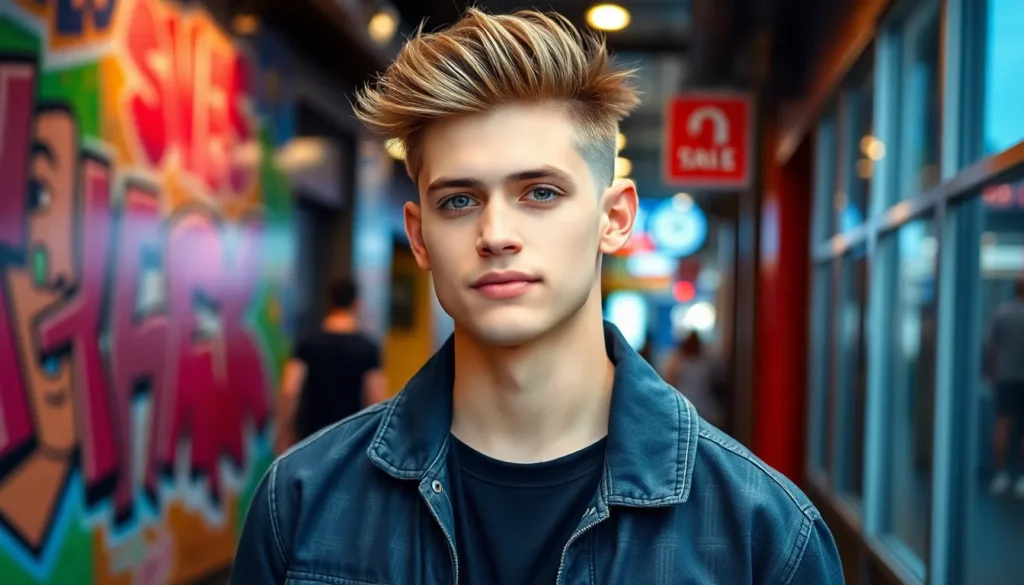The modern mullet fade has officially shed its reputation as just a retro throwback and emerged as one of today’s most versatile and stylish haircuts. We’re witnessing a complete transformation of this classic cut that’s captivating everyone from celebrities to everyday trendsetters who want to make a bold statement.
What makes today’s mullet fade so appealing is its perfect balance of edgy rebellion and refined sophistication. Unlike the dramatic mullets of the past this contemporary version features seamless fade transitions that create a polished yet daring look. We’ve seen how skilled barbers can customize the fade height length ratios and styling techniques to complement any face shape or personal aesthetic.
Whether you’re considering your first mullet or looking to upgrade your current style we’ll guide you through everything you need to know about this game-changing haircut that’s redefining modern men’s grooming.
Understanding the Modern Mullet Fade: A Contemporary Take on a Classic Style
Modern mullet fades represent a sophisticated evolution of the traditional business-up-front, party-in-the-back philosophy. We’ve witnessed this classic hairstyle transform into something remarkably refined, incorporating seamless fade techniques that create smooth transitions between lengths. Professional barbers now create these cuts with precision clippers and expert blending skills, resulting in a polished appearance that works in both casual and formal settings.
The contemporary version differs significantly from its 1980s predecessor through strategic layering and graduated fading. Where traditional mullets featured harsh contrasts and obvious length differences, we see today’s interpretations embracing subtle transitions and textured finishes. Skilled stylists use various fade heights including low fades, mid fades, and high fades to customize the look for different face shapes and personal preferences.
Versatility defines the modern mullet fade’s appeal across diverse demographics and style preferences. Musicians like Post Malone and Machine Gun Kelly have popularized variations that blend streetwear aesthetics with mainstream fashion sensibilities. Athletes including NFL players and soccer stars have adopted cleaner, more structured versions that maintain professional appearances while expressing individual personality.
Technical execution involves exact cutting techniques that distinguish quality modern mullet fades from amateur attempts. We recommend seeking barbers who understand proper blend ratios, typically maintaining 2:1 or 3:1 length proportions between front and back sections. Expert practitioners create imperceptible transitions using clipper-over-comb methods, ensuring the fade appears natural rather than choppy or disconnected.
Styling options for modern mullet fades accommodate various hair textures and daily maintenance preferences. Straight hair benefits from texturizing products that add movement and prevent the back section from appearing too heavy or flat. Curly and wavy hair types naturally enhance the style’s dimension, requiring minimal product application beyond light oils or curl-defining creams for optimal results.
Choosing the Right Modern Mullet Fade for Your Face Shape
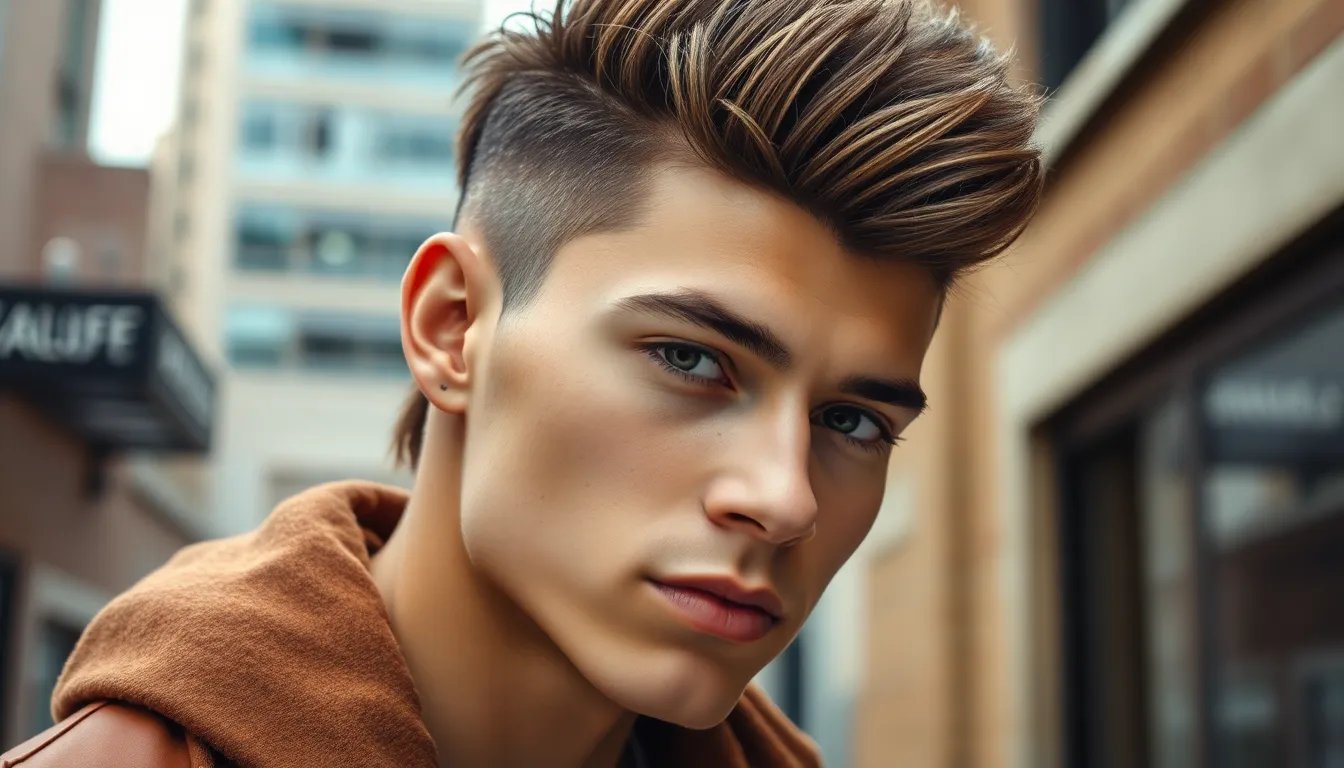
Face shape compatibility determines the success of your modern mullet fade selection. We’ll guide you through optimal styles that enhance your natural features and create balanced proportions.
Round Face Shapes
Angular cuts work best for round faces by creating definition and structure. We recommend high fade mullets with pronounced layers that add vertical lines to elongate your appearance. Sharp transitions at the temples draw attention upward while the textured back length provides visual weight distribution.
Volume placement becomes crucial for achieving the ideal silhouette. Build height at the crown using strategic layering techniques that create lift without excessive width. Avoid blunt cuts across the sides that emphasize roundness, instead choosing graduated fades that taper smoothly from temple to neckline.
Styling products help maintain the structured appearance throughout the day. Use matte paste or clay to define the angular elements while keeping natural movement in the longer sections. Professional barbers often suggest side part placement to break up circular patterns and create asymmetrical balance.
Square Face Shapes
Softening techniques reduce harsh jawline prominence through careful fade placement and texture work. We suggest medium fade mullets that blend seamlessly into longer back sections, creating curved transitions that counteract angular features. Textured layers throughout the cut add movement and visual interest.
Crown styling requires special attention to avoid adding unwanted width at the temples. Keep sides relatively short while allowing gradual length increases toward the back, maintaining proportional balance. Rounded fade techniques work better than sharp linear cuts for square face structures.
Flexible styling approaches accommodate your strong facial features effectively. Apply lightweight mousse to damp hair for natural texture, then use your fingers to tousle the longer sections. Professional colorists sometimes recommend subtle highlights in the back length to create depth and dimension.
Oval Face Shapes
Versatility defines the oval face advantage in modern mullet fade selection. We can experiment with various fade heights and length combinations since your balanced proportions accommodate most style variations. Both high and low fades work equally well, allowing personal preference to guide your choice.
Proportional balance comes naturally with oval shaped faces, offering freedom in creative expression. Consider dramatic length contrasts between front and back sections, or opt for subtler transitions based on your lifestyle needs. Textural elements enhance the natural harmony of your facial structure.
Maintenance schedules vary depending on your chosen style complexity. Schedule touch ups every 3-4 weeks to maintain clean fade lines and prevent the longer sections from becoming unruly. Regular trimming keeps the overall shape intact while allowing continued growth in desired areas.
Heart-Shaped Faces
Forehead balance requires strategic fade placement to minimize width at the temples. We recommend lower fade starting points that maintain hair density through the mid sections, creating visual weight that balances narrower chin areas. Longer back sections add fullness below the jawline.
Textural contrast works exceptionally well for heart shaped faces through varied cutting techniques. Incorporate choppy layers in the crown area to reduce apparent forehead width while keeping smoother transitions in the lower sections. Side swept bangs can further minimize forehead prominence when desired.
Styling emphasis should focus on adding volume around the jaw and neck areas. Use volumizing products in the longer back sections while keeping the top relatively controlled. Professional stylists often suggest asymmetrical parting to break up the natural triangle shape and create more balanced proportions.
Exploring Different Modern Mullet Fade Variations

We’ll explore the four primary fade variations that define today’s mullet industry, each offering distinct advantages for different style preferences and face shapes.
Low Fade Mullet
Low fade mullets create the most subtle transition by starting the fade just above the ears and neckline. This conservative approach maintains more hair length on the sides while preserving the classic mullet silhouette. Barbers typically begin the fade around the temple area, gradually blending into longer hair that extends toward the back.
Professional settings often favor low fade mullets because they appear less dramatic than higher fade variations. The extended hair coverage provides versatility for styling, allowing you to slick back the sides for formal occasions or tousle them for casual looks. Musicians like Harry Styles have popularized this variation by pairing it with textured styling products that enhance natural movement.
Maintenance requirements for low fade mullets are minimal compared to other variations, requiring touch ups every 3-4 weeks. The gradual fade means regrowth appears less noticeable, making this option ideal for those with busy schedules or budget constraints.
Mid Fade Mullet
Mid fade mullets position the fade transition around the middle of the head, typically starting at ear level. This balanced approach creates more contrast than low fades while maintaining enough coverage to avoid extreme looks. Barbers use clipper guards ranging from #2 to #4 to achieve the perfect blend between short and long sections.
Athletes like soccer players and hockey stars frequently choose mid fade mullets because they offer functionality during physical activity while maintaining style appeal. The moderate fade height provides excellent airflow around the ears and temples, preventing overheating during intense workouts or competitions.
Styling versatility reaches its peak with mid fade variations, accommodating both sleek professional looks and textured casual styles. Products like sea salt sprays work exceptionally well with this cut, adding volume and definition to the longer sections while keeping faded areas neat.
High Fade Mullet
High fade mullets create the most dramatic contrast by starting the fade well above the ears, often reaching the temple area. This bold variation emphasizes the length difference between front and back sections, making it the most statement driven option in modern mullet styling. Barbers must possess advanced blending skills to execute clean transitions at such elevated starting points.
Creative professionals in fashion, art, and entertainment gravitate toward high fade mullets because they project confidence and individuality. The important contrast draws attention to facial features while showcasing the longer hair sections at the crown and back. This variation works exceptionally well with angular face shapes, creating vertical lines that elongate the overall appearance.
Color treatments complement high fade mullets beautifully, with many clients adding highlights or subtle tints to the longer sections. The stark contrast makes color variations more prominent, allowing for creative expression through both cut and color choices.
Skin Fade Mullet
Skin fade mullets represent the most extreme variation, blending hair down to the skin level around the sides and back. This ultra modern approach creates maximum contrast between the completely shaved areas and the flowing hair sections. Master barbers use various clipper techniques and straight razor finishing to achieve perfectly smooth transitions from skin to hair.
Urban fashion influencers and hip hop artists frequently showcase skin fade mullets because they embody cutting edge style trends. The clean, sharp lines created by skin level fading require exceptional precision and technique, making this variation a showcase of barbering expertise.
Weekly maintenance becomes essential with skin fade mullets, as regrowth appears more obvious against the clean shaved sections. But, this high maintenance requirement rewards you with the most polished and contemporary mullet appearance available in today’s styling industry.
Preparing for Your Modern Mullet Fade Appointment
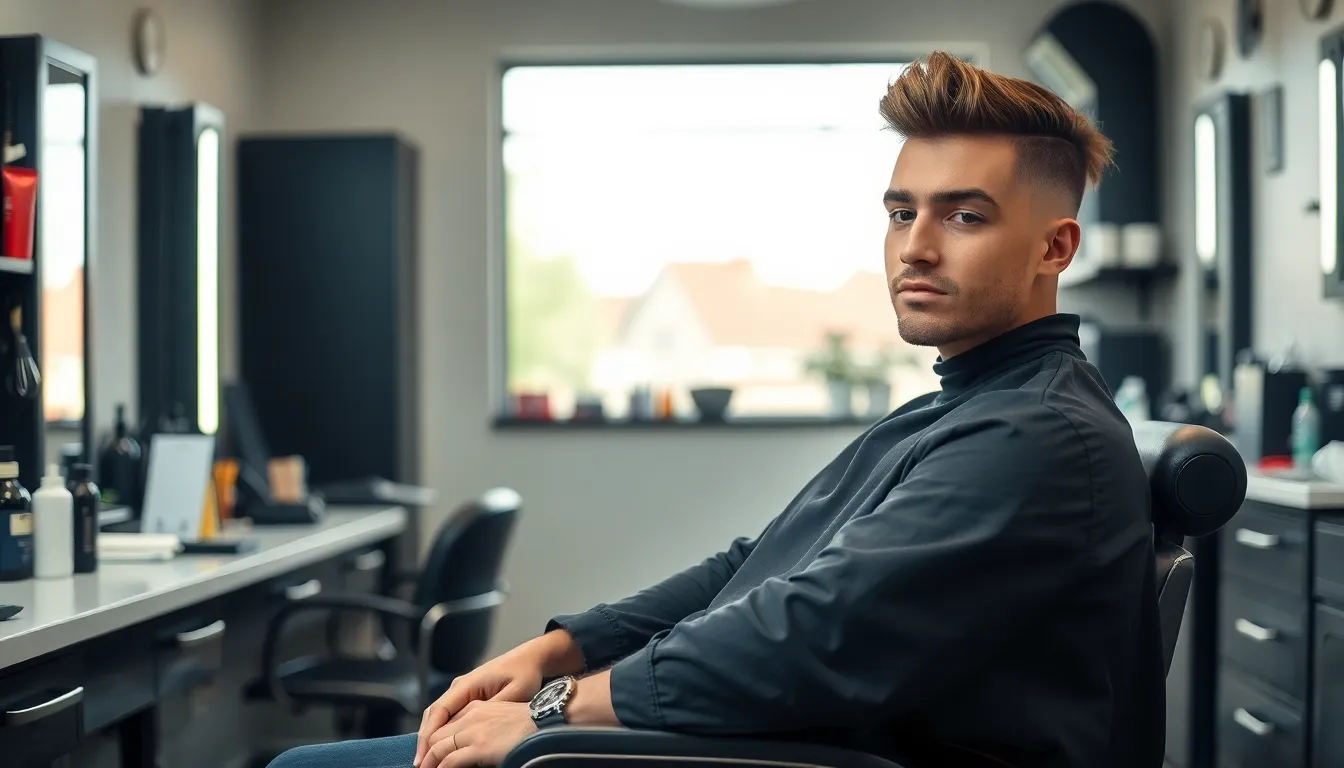
Success with modern mullet fade techniques requires careful preparation before you sit in that barber chair. Planning ahead ensures you’ll walk away with the sophisticated style you’re envisioning.
Finding the Right Barber
Research barbers who specialize in modern fade techniques rather than settling for any available appointment. Instagram portfolios reveal their expertise with mullet fade transitions and showcase recent work quality. Reviews from clients who’ve received similar cuts provide insight into consistency and attention to detail.
Schedule consultations at multiple shops to discuss your vision and assess their understanding of contemporary mullet styling. Barbers experienced with modern mullet fades demonstrate knowledge of proper blend ratios and graduated cutting techniques. Professional shops typically display certifications and maintain clean workstations that reflect their commitment to quality.
Ask about their experience with your hair type since different textures require adjusted approaches for optimal results. Skilled barbers adapt their techniques for straight hair movement enhancement or curly hair definition requirements.
Bringing Reference Photos
Collect 3-5 high quality photos showing different angles of your desired modern mullet fade style. Front view images help barbers understand face shape compatibility while side profiles reveal fade placement preferences. Back shots demonstrate the length contrast you’re seeking between upper and lower sections.
Choose photos that match your hair texture and density to ensure realistic expectations during your appointment. Celebrity references work well but consider everyday styling practicality for your lifestyle needs. Multiple examples allow your barber to identify common elements and customize the cut accordingly.
Save images to your phone for easy sharing and discussion during the consultation process. Screenshots from social media often lack the resolution needed for detailed analysis.
Discussing Maintenance Requirements
Establish a realistic maintenance schedule based on your chosen fade variation and personal grooming routine. Low fade mullets typically require touch ups every 4-6 weeks while skin fades need attention every 2-3 weeks for optimal appearance.
Budget for regular appointments since modern mullet fades rely on precise transitions that grow out noticeably. Professional maintenance preserves the sophisticated look that separates contemporary styles from outdated versions. Discuss pricing for future visits to avoid surprise costs.
Learn about at home styling requirements including recommended products and daily maintenance routines. Barbers can suggest exact pomades for straight hair movement or curl defining creams for textured styles. Understanding these needs prevents styling frustrations between appointments.
Styling Your Modern Mullet Fade at Home
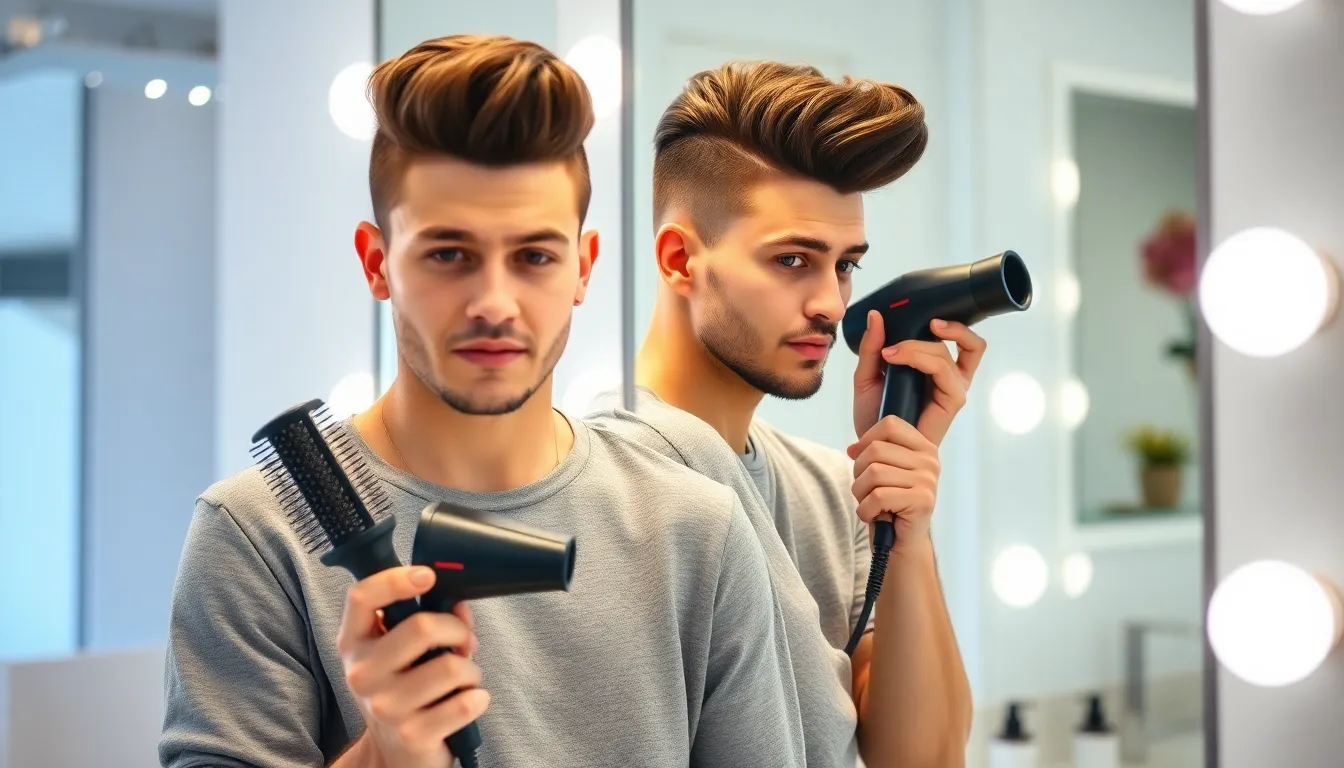
Maintaining your modern mullet fade’s polished appearance requires the right approach and quality products. We’ll guide you through professional styling techniques that keep your fade looking fresh between barbershop visits.
Essential Products and Tools
Quality styling products form the foundation of effective modern mullet fade maintenance. We recommend starting with a lightweight pomade or styling cream that provides hold without weighing down your hair’s natural movement. Brands like American Crew Fiber or Hanz de Fuko Claymation offer excellent texture control for the longer sections while maintaining flexibility throughout the day.
Professional grade clippers become essential for maintaining your fade’s crisp edges between appointments. We suggest investing in adjustable clippers with guards ranging from #1 to #4 to touch up the gradual transitions. Wahl Magic Clip or Andis Master models provide the precision needed for home maintenance without compromising the fade’s integrity.
Texturizing tools enhance your mullet’s dimensional appearance and styling versatility. We use sea salt spray for natural texture on air-dried styles, while a quality blow dryer with diffuser attachment helps create volume in the crown area. Round brushes in medium sizes work best for directing the longer back sections during styling sessions.
Daily Styling Techniques
Morning preparation starts with slightly damp hair for optimal product distribution and control. We apply styling product from mid-lengths to ends, avoiding the scalp area to prevent weighing down the fade’s clean lines. Work the product through with your fingers first, then use a wide-tooth comb to ensure even coverage throughout the longer sections.
Blow drying technique shapes your modern mullet fade’s overall silhouette and creates lasting hold. We recommend using medium heat while directing airflow from roots to ends, lifting the crown section for added volume. Focus the dryer on the transition areas where the fade meets longer hair, smoothing these sections for seamless blending.
Finishing touches involve strategic hand styling to enhance your mullet’s natural movement and texture. We gently tousle the back sections with our fingers to create subtle separation and avoid overly structured appearances. Light misting with flexible hold hairspray sets the style while maintaining touchable softness throughout the day.
Creating Texture and Volume
Scrunching methods activate your hair’s natural texture while building volume in the longer mullet sections. We apply texturizing mousse to towel-dried hair, then scrunch sections upward from ends to mid-lengths. This technique works especially well for wavy or curly hair types, improving the mullet’s distinctive silhouette.
Root lifting techniques create height and dimension in the crown area without disrupting the fade’s clean graduation. We use a small round brush while blow drying, rolling sections away from the scalp and holding briefly with cool air. Volumizing powder applied at the roots provides additional lift for fine hair textures.
Strategic layering enhancement involves finger-combing exact sections to emphasize the mullet’s length variation and movement. We separate the longer pieces in the back, gently pulling them forward and releasing to create natural-looking layers. Lightweight oil or serum on the ends prevents frizz while adding subtle shine that highlights the style’s modern sophistication.
Maintaining Your Modern Mullet Fade Between Cuts

We believe consistent maintenance between barber visits is crucial for preserving your modern mullet fade’s sharp appearance and professional polish.
Proper Washing and Conditioning
Gentle cleansing maintains the integrity of your fade without stripping natural oils that keep hair healthy. We recommend washing your modern mullet fade every 2-3 days using sulfate-free shampoos that won’t cause color fading or dryness. Focus the shampoo application on your scalp rather than the lengths, allowing the suds to cleanse the hair naturally as you rinse.
Deep conditioning treatments should target the longer sections of your mullet once weekly. Apply conditioner from mid-length to ends, avoiding the faded areas where buildup can weigh down the style. Leave-in conditioners work exceptionally well for maintaining moisture in the back section while keeping the sides light and manageable.
Water temperature plays a important role in maintaining your fade’s appearance. Cold water rinses seal the hair cuticle and enhance shine, while hot water can cause frizz and disrupt your styling routine. We suggest lukewarm washing followed by a cool final rinse for optimal results.
Regular Touch-Up Schedule
Weekly edge maintenance keeps your modern mullet fade looking fresh between appointments. Schedule light touch-ups around the ears and neckline using your home clippers every 7-10 days. Professional barbers typically recommend maintaining the same guard length used during your initial fade to preserve the gradient.
Bi-weekly shape adjustments help control the mullet’s growth pattern and prevent awkward stages. Trim any stray hairs that disrupt the clean lines around your temples and sideburns. Focus on maintaining the established fade boundaries rather than attempting to recreate the entire cut.
Monthly professional maintenance appointments ensure your modern mullet fade retains its sophisticated appearance. Book these sessions 3-4 weeks after your initial cut when the fade begins losing its sharpness. Regular maintenance costs typically range from $25-45, depending on your location and barber’s expertise.
At-Home Trimming Tips
Essential tools for home maintenance include professional-grade clippers with multiple guard sizes, sharp haircutting scissors, and a quality handheld mirror. Invest in clippers with ceramic blades that stay sharp longer and produce cleaner cuts. We recommend brands like Wahl or Andis that barbers trust for consistent performance.
Safety techniques prevent common trimming mistakes that can ruin your fade. Start with longer guard lengths and work gradually shorter, checking your progress frequently in good lighting. Never attempt to recreate the entire fade at home, focusing only on maintaining existing lines and removing obvious growth.
Systematic approach ensures even results when touching up your modern mullet fade. Begin with the longest sections and work toward shorter areas, following the natural growth patterns established by your barber. Trim small amounts at a time, stepping back to assess your work every few passes to avoid overcutting.
Adapting Your Modern Mullet Fade for Different Occasions

Your modern mullet fade transforms effortlessly from boardroom presentations to weekend adventures. We’ll show you how to style this versatile cut for any situation while maintaining its distinctive character.
Professional Settings
Professional environments call for a polished approach that tames the mullet’s wild reputation. We recommend applying a medium hold pomade to damp hair and combing the front sections forward for a clean business look. Sleek styling keeps the fade crisp while the longer back layers remain controlled and sophisticated.
Corporate meetings benefit from blow drying the hair straight back, creating volume at the crown while keeping the sides tight. Executive styling requires using a flat iron on the longer sections to eliminate any unruly waves or curls. Banking professionals and lawyers often choose this refined approach to maintain credibility while showcasing their modern edge.
Conservative workplaces appreciate when you use a strong hold gel to create sharp part lines that emphasize the fade’s technical precision. Traditional styling involves combing everything into place and setting it with light hairspray for all day hold. Teachers, accountants, and government workers find this approach strikes the perfect balance between contemporary and conventional.
Medical professionals and consultants succeed by keeping their mullet fade subtle through strategic product application. Clinical styling means using matte finish products that provide hold without shine, creating a natural appearance that doesn’t distract from professional interactions.
Casual Weekend Looks
Weekend styling unleashes your mullet fade’s personality through relaxed, effortless techniques. We suggest scrunching sea salt spray into towel dried hair for natural texture that enhances the cut’s inherent movement. Beachy styling creates waves throughout the longer sections while maintaining the fade’s clean structure.
Outdoor activities benefit from lightweight leave in conditioner that protects against sun and wind damage. Athletic styling involves pulling the front sections back with a small amount of styling cream while letting the back flow naturally. Hikers, cyclists, and weekend warriors appreciate this low maintenance approach that looks good in action shots.
Social gatherings call for enhanced texture through diffusing your hair with a blow dryer on low heat. Relaxed styling means working texturizing paste through the ends to create separation and definition. Coffee shop visits, farmers markets, and casual dining experiences suit this approachable look perfectly.
Hobby pursuits like woodworking or gardening require protective styling that keeps hair out of your face. Functional styling uses headbands or styling gel to secure front sections while preserving the mullet’s distinctive silhouette underneath caps or safety gear.
Special Events and Nights Out
Evening occasions demand elevated styling that showcases your mullet fade’s dramatic potential. We recommend using high shine pomade worked through damp hair before blow drying with a round brush for maximum volume. Glamorous styling creates height at the crown while the fade provides striking contrast under venue lighting.
Date nights benefit from tousled texture achieved through finger styling with texturizing cream. Romantic styling involves creating soft waves in the longer sections while keeping the faded sides perfectly groomed. Restaurant dinners and theater performances suit this sophisticated yet approachable aesthetic.
Club environments call for bold styling choices that make your mullet fade stand out in crowded spaces. Edgy styling means using strong hold gel to create spiky texture in the crown while slicking back the sides for dramatic effect. Dance floors and concert venues provide the perfect backdrop for this confident look.
Wedding celebrations require formal styling that complements your outfit without overwhelming the occasion. Ceremonial styling involves using smoothing serum to eliminate frizz before creating gentle waves with a curling iron on the longer sections. Reception parties and formal gatherings appreciate this refined interpretation of the modern mullet fade.
Troubleshooting Common Modern Mullet Fade Issues
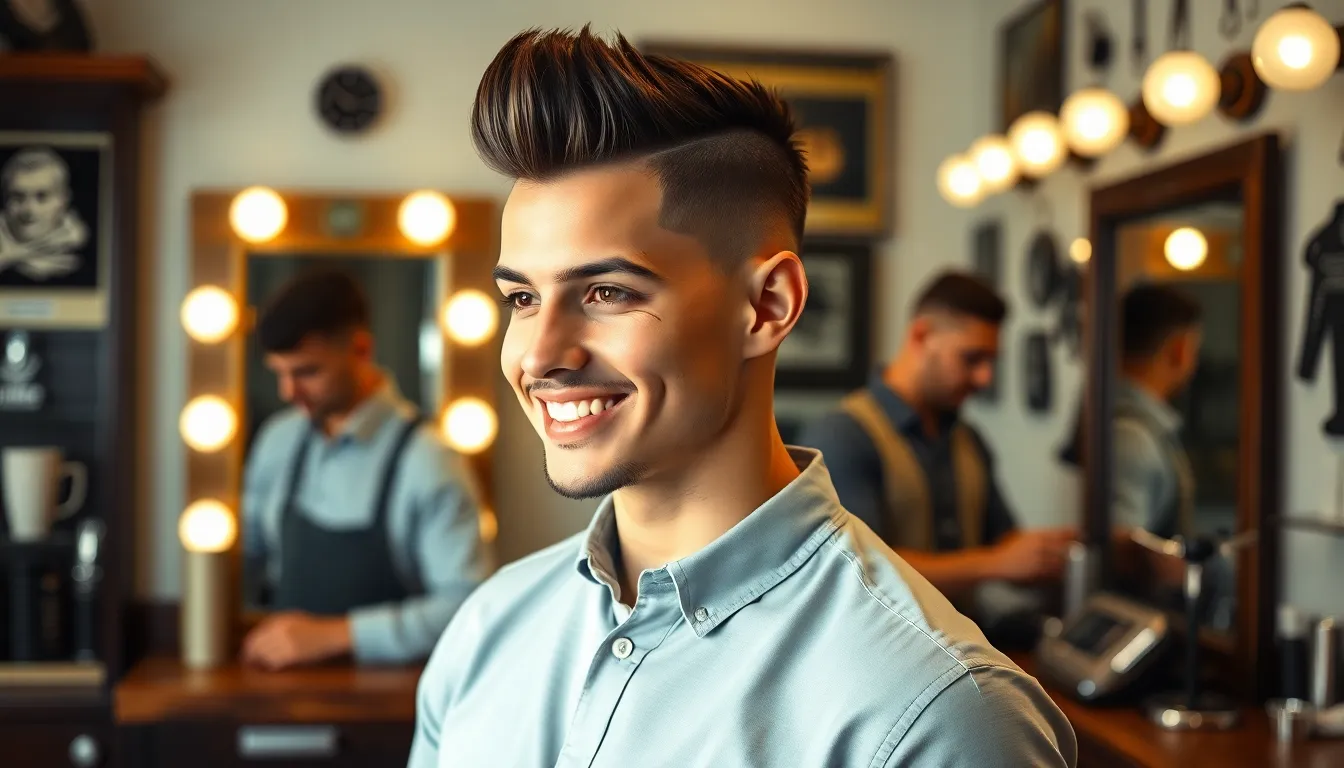
Even with proper maintenance and styling techniques, modern mullet fades can present challenges that require strategic answers. We’ll help you navigate the most common issues and provide expert fixes to keep your mullet fade looking sharp.
Dealing with Awkward Growth Phases
Growing out a modern mullet fade creates uncomfortable in-between stages that test your patience. Weeks 3-4 typically present the biggest challenges as the fade begins losing its crispness while the top and back sections haven’t developed sufficient length contrast. We recommend scheduling mini touch-up appointments every 10-14 days during this period to maintain clean edges without disrupting the overall growth pattern.
Strategic styling helps disguise awkward proportions during these transitional phases. Apply texturizing paste to damp hair and scrunch the longer sections while keeping the sides slicked down with pomade. This technique creates intentional contrast that masks uneven growth patterns until your mullet reaches its target length.
Temporary adjustments to your styling routine can bridge the gap between appointments. Consider wearing headbands or backward caps during particularly challenging growth weeks, as these accessories naturally compress problematic areas while maintaining the mullet’s distinctive silhouette. Baseball caps work especially well for hiding fade lines that have grown out past their optimal appearance.
Fixing Uneven Lengths
Uneven cutting creates lopsided mullets that undermine the style’s sophisticated balance. DIY trimming attempts often result in one side being longer than the other, disrupting the symmetrical flow that defines quality modern mullet fades. We strongly advise against attempting major corrections at home, as amateur fixes typically compound the original problem.
Professional assessment identifies the root cause of length discrepancies before implementing corrections. Skilled barbers examine your natural growth patterns, cowlicks, and head shape to determine whether unevenness stems from poor cutting technique or natural hair characteristics. This diagnostic approach prevents unnecessary over-correction that could compromise your mullet’s overall proportions.
Gradual correction preserves maximum length while restoring symmetry to your modern mullet fade. Rather than dramatically cutting the longer side to match the shorter one, experienced barbers strategically blend sections over 2-3 appointments. This patient approach maintains the mullet’s length goals while achieving balanced proportions that complement your facial structure.
Interim styling techniques can camouflage minor asymmetry between correction appointments. Side-part your hair toward the shorter side to create visual balance, or use asymmetrical styling products that add volume to deficient areas. These temporary answers keep your mullet looking intentional while professional corrections gradually restore perfect symmetry.
Managing Different Hair Textures
Coarse hair requires specialized techniques to achieve smooth fade transitions in modern mullet styles. Dense, wiry hair tends to stick out at awkward angles during fade zones, creating harsh lines instead of seamless blends. We recommend using thinning shears and longer guard lengths during the cutting process to prevent the choppy appearance that often plagues coarse-haired mullets.
Fine hair presents opposite challenges that demand different answers for successful mullet fades. Thin strands struggle to create the volume and texture that define compelling modern mullets, often resulting in flat, lifeless styles. Layered cutting techniques and volumizing products become essential for fine-haired individuals seeking substantial mullet presence without overwhelming their natural hair density.
Curly hair transforms traditional mullet fade approaches through specialized cutting and styling methods. Natural curl patterns create unique opportunities for texture variation between fade zones and longer sections, but require barbers who understand how curls behave when shortened. We suggest working with curl specialists who can predict how your exact curl pattern will respond to different length combinations.
Product selection varies dramatically based on your hair’s natural characteristics and texture needs. Coarse hair benefits from smoothing creams and anti-frizz serums that tame unruly sections while maintaining hold. Fine hair responds better to lightweight mousses and dry shampoos that add grip without weighing down delicate strands. Curly hair requires leave-in conditioners and curl-defining creams that enhance natural patterns while preventing frizz in humid conditions.
Regular texture-exact maintenance prevents common problems before they develop into major issues. Schedule monthly deep conditioning treatments for coarse hair to maintain manageability, while fine hair benefits from clarifying shampoos that remove product buildup. Curly mullet fades require specialized trim techniques that account for curl spring-back, ensuring consistent length maintenance between appointments.
Conclusion
The modern mullet fade has firmly established itself as more than just a passing trend—it’s a legitimate hairstyle choice that bridges the gap between edgy self-expression and professional polish. We’ve seen how this evolved cut offers unprecedented versatility through its various fade heights and customization options.
Success with your modern mullet fade eventually comes down to three key factors: choosing an experienced barber who understands contemporary fade techniques finding the right variation that complements your face shape and lifestyle and committing to proper maintenance routines that preserve the cut’s sharp appearance.
Whether you’re drawn to the subtle sophistication of a low fade or the bold statement of a skin fade mullet we’re confident this comprehensive guide has equipped you with the knowledge needed to make an well-informed choice. Your modern mullet fade journey starts with that first consultation—and the results can truly transform your entire look.
Frequently Asked Questions
What is a modern mullet fade and how is it different from the traditional mullet?
The modern mullet fade is a sophisticated evolution of the classic mullet, featuring seamless transitions and refined fade techniques instead of harsh contrasts. Unlike the 1980s version, today’s mullet fades use strategic layering and graduated fading to create a polished appearance suitable for both casual and formal settings while maintaining the business-front, party-back philosophy.
What are the main types of modern mullet fade variations?
There are four primary fade variations: low fade (subtle transition, professional-friendly), mid fade (balanced contrast and coverage), high fade (bold statement with dramatic contrasts), and skin fade (most extreme variation with sharp contrasts). Each offers different levels of contrast and maintenance requirements to suit various lifestyles and preferences.
How do I choose the right mullet fade for my face shape?
Round faces benefit from angular cuts with high fades and pronounced layers for definition. Square faces work well with medium fade mullets that soften jawlines through curved transitions. Oval faces can accommodate various fade heights and lengths, while heart-shaped faces need strategic fade placement to balance forehead width and add fullness below the jawline.
What should I look for when choosing a barber for a modern mullet fade?
Research barbers through their Instagram portfolios and client reviews, focusing on those who specialize in modern fade techniques. Schedule a consultation to discuss your vision, ensure they understand your hair type, and bring reference photos. Look for barbers who demonstrate expertise in proper blend ratios and cutting techniques for natural-looking results.
How often do I need to maintain my modern mullet fade?
Professional maintenance appointments should be scheduled monthly to preserve the fade’s sharp appearance. Bi-weekly shape adjustments help maintain clean lines, while mini touch-up appointments during growth phases prevent awkward styling periods. Regular at-home maintenance with quality clippers can extend time between professional visits.
What products work best for styling a modern mullet fade?
Use lightweight pomades or creams for hold and movement on straight hair, while defining products work well for curly textures. Sea salt spray creates casual texture, medium-hold pomade maintains professional looks, and high-shine products elevate the style for special occasions. Choose sulfate-free shampoos and deep conditioning treatments for healthy hair.
Can I style my modern mullet fade for different occasions?
Yes, the modern mullet fade is highly versatile. For professional settings, use medium-hold pomade for a polished look. Casual weekend styles benefit from scrunched sea salt spray for relaxed texture. Special events call for high-shine pomade and volume techniques, while date nights work well with tousled, textured styling approaches.
How do I manage common mullet fade problems like uneven growth?
Schedule mini touch-up appointments during awkward growth phases and use strategic styling techniques to disguise uneven lengths. Apply products to damp hair, use blow-drying for volume, and employ scrunching methods for texture. Regular professional maintenance and proper at-home care prevent most common styling issues from developing.

